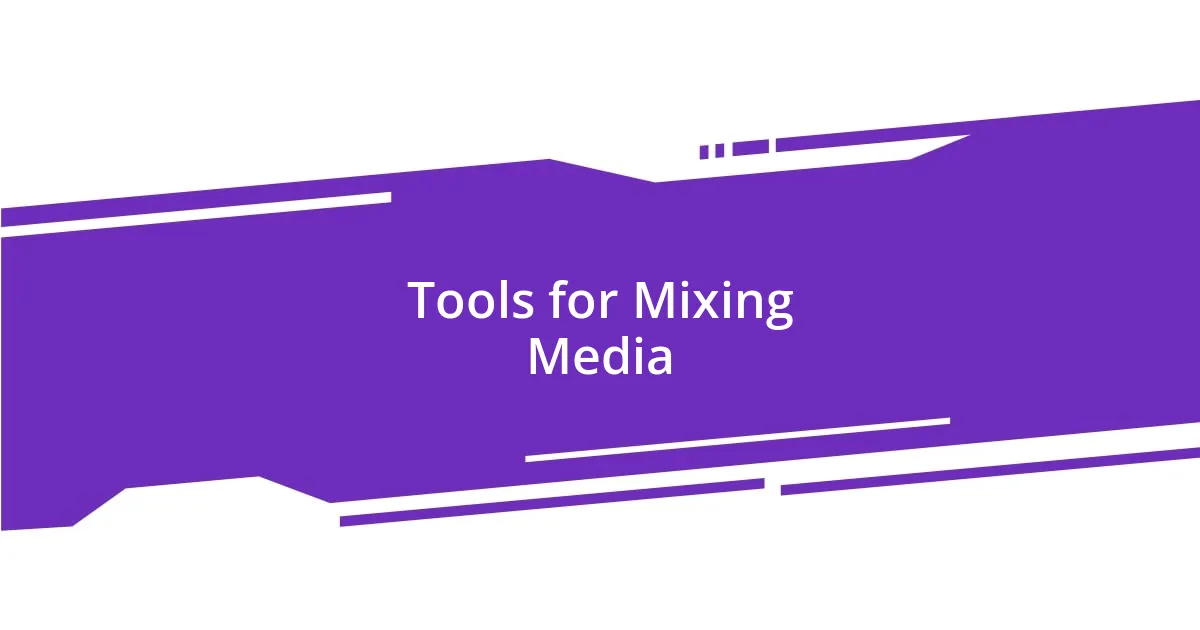Key takeaways:
- Mixing media enhances emotional expression and engages multiple senses, fostering a deeper connection with viewers.
- Successful mixing requires quality tools, including brushes, adhesives, and diverse surfaces to create unique textures and effects.
- Common mistakes include neglecting drying times, being too attached to specific materials, and lacking a planned composition; flexibility and planning are essential for better results.
- Experimentation is crucial; techniques such as layering, contrasting, and integrating textural elements contribute to innovative mixed media artworks.

Benefits of Mixing Media
Mixing media in art is like giving your creativity a playground to explore. I remember the first time I combined watercolor and charcoal—it was thrilling to watch the fluidity of the paint intertwine with the stark, bold lines of the charcoal. It felt like a conversation between two mediums, each enhancing the other’s qualities. How often do we limit ourselves by sticking to one medium? Stepping outside that comfort zone opens new doors.
One significant benefit of mixing media is the ability to express complex emotions more vividly. In my experience, using textured materials like fabric alongside traditional paints allowed me to convey feelings of warmth and comfort distinctly. This fusion created a tactile experience that resonated deeply with viewers. Wouldn’t it be incredible if every artwork could evoke multiple senses and emotions?
Additionally, blending different materials encourages problem-solving and innovation. I often found myself faced with challenges when combining various media—like how to prevent watercolors from smudging with pastels. Each hurdle propelled me to experiment, fostering an environment where failure was just a stepping stone to discovery. Isn’t that what creativity is all about? Embracing these unique challenges not only refines our skills but also fuels growth as artists.

Tools for Mixing Media
Mixing media requires the right tools to achieve desired effects. I’ve always found that investing in quality brushes can make a significant difference when working with acrylics and oils together. The variety of bristle types, sizes, and shapes allows for versatile applications, enhancing texture and depth. Have you ever experimented with different brushes? You might be surprised at how much they can transform your artwork.
In my art journey, I discovered the value of a reliable adhesive when working with mixed materials. Glue, gel mediums, and even tape can seamlessly bind various elements together, allowing for a cohesive final piece. I remember a project where I used washi tape to attach pieces of paper and photos to a canvas; the colors and patterns created a delightful contrast that I didn’t expect. The right adhesive can elevate the whole experience, making everything feel intentional and well-designed.
When it comes to tools for mixing media, don’t underestimate the power of good surface materials. I often choose canvas, wood panels, or even repurposed items like cardboard. Each surface interacts differently with various media, which can inspire unexpected results. For instance, I’ve enjoyed the unique texture of painting on wood—it absorbs acrylics differently, creating a warmth that stands out in my mixed media pieces. By experimenting with surfaces, you might find a new favorite backdrop for your artistic expression.
| Tool | Description |
|---|---|
| Brushes | Quality brushes offer diverse styles for various media, enhancing texture and application. |
| Adhesives | Different glue types and gel mediums bond mixed materials effectively, providing artistic freedom. |
| Surfaces | Canvas, wood, and unconventional materials influence the final artwork’s texture and interaction. |

Techniques for Successful Mixing
When it comes to techniques for successfully mixing media, experimentation is key. I clearly remember the excitement of layering ink with collage elements. The intricate interplay between the bold ink lines and the subtle textures of the paper brought an unmatched dynamism to my work. This experimentation is what keeps the creative spark alive, so don’t hesitate to play around with both the materials and the techniques.
Here are some strategies I’ve found helpful:
– Layering: Start with a base layer and progressively add more media. Each layer can change the overall feel.
– Contrast: Choose materials that create stark contrasts, whether it’s smooth versus rough or transparent versus opaque.
– Blending Colors: Experiment with mixing colors from different media to create unique shades. In one piece, I mixed acrylics with crayons, resulting in a vivid, textured surface that caught the light beautifully.
– Textural Elements: Integrate materials like string, sand, or even nature elements. I’ve added twigs to a piece, enhancing both depth and intrigue.
– Emotional Intention: Before you begin, set an emotional intention for your artwork. This gives your choices a purpose and creates a more cohesive piece.
Ultimately, I’ve found that being open to the unexpected often leads to the most rewarding results in mixed media art. Embrace the surprising outcomes!

Common Mistakes to Avoid
When diving into mixed media, one of the biggest mistakes I see is overlooking the drying times of each material. I learned this the hard way when I rushed a piece and layered wet paints over wet glues. The result? A muddy mess that completely derailed my vision. Timing truly is everything; taking a moment to pause and allow each layer to dry can save you from frustration and enhance the clarity of your artwork.
Another common misstep involves being overly attached to specific materials. I vividly remember an instance where I insisted on using a particular type of paper that just didn’t mesh well with my chosen paints. As a result, the colors didn’t pop, and the composition suffered. It’s important to remain flexible and open to adjusting your materials mid-project. Sometimes, a spontaneous change can lead you to something beautifully unexpected.
Finally, don’t underestimate the importance of planning your composition. Early in my creative journey, I often jumped in without a clear direction, resulting in disjointed pieces. I began sketching out my ideas beforehand, which transformed not only my process but also the final outcome. Can you remember a time when a little structure turned chaos into clarity? That shift in mindset made all the difference in my approach to mixed media.

Examples of Mixed Media Works
One of the standout examples of mixed media that I absolutely adore is the work by contemporary artist Robert Rauschenberg. He famously combined painting, photography, and found objects, creating pieces that are both visually striking and thought-provoking. I remember first seeing his “Combines” and being struck by how everyday items could coexist beautifully on a canvas. It made me wonder: what if I started incorporating more unconventional materials in my own projects?
Another inspiring piece that comes to mind is “The Dinner Party” by Judy Chicago. This artwork combines craft techniques like needlework and ceramics with feminist narratives, each place setting telling a story. The emotional resonance in her work reminds me of my own moments where I’ve tried to infuse personal history into my art. Consider how your own experiences can enrich your mixed media creations—what story are you eager to share?
An inspiring journey into mixed media also can be found in the work of artist Ann Hamilton. Her installation “the event of a thread” beautifully intertwines text, sound, and fabric. I distinctly recall walking through her installation, feeling completely enveloped by how each element interacted with the others. It lit a fire in me to think beyond traditional boundaries—how can we use more than just paint to convey feelings? These artists teach me that mixed media can be an extraordinary language in itself, full of layers and meaning waiting to be discovered.












